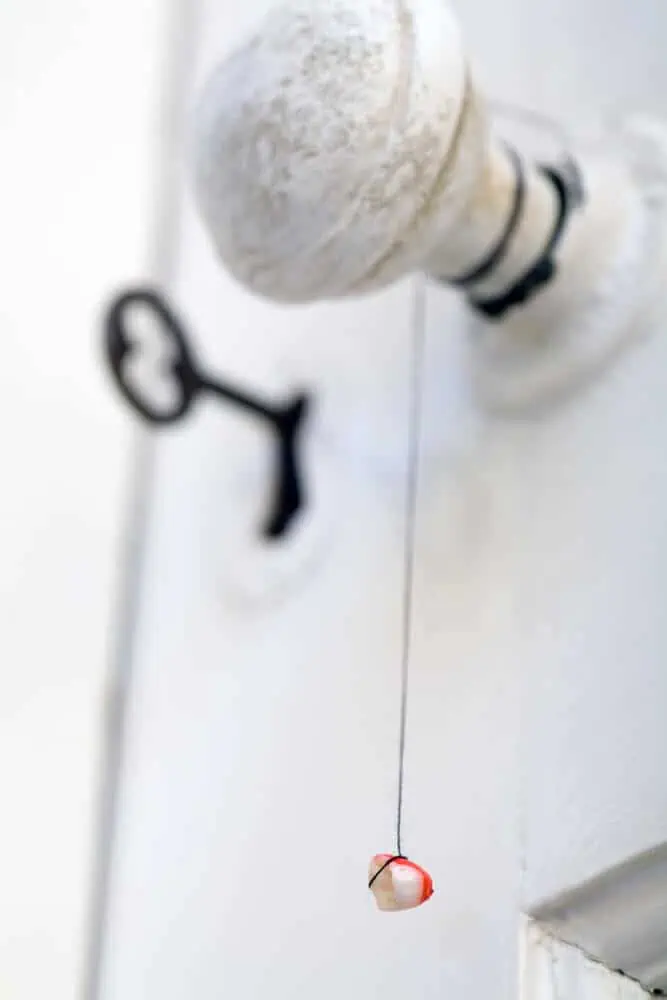Wondering how to pull a tooth out at home? Well, stop right there! Unless you’re a trained dentist, or we’re talking about a super wiggly baby tooth, you should not try to remove a tooth yourself.
And even if it is a baby tooth, you it’s best let it fall out on its own, no matter how loose it already is.
Removing a tooth at home is going to put you at risk of infection, not to mention immense pain. A trip to the dentist will ensure you get the right treatment and protect your other teeth and overall dental health. Who knows, maybe the dentist can save the tooth you think needs to be removed!
So let’s look at why a tooth might need to be pulled, how to do it at home, and the reasons why you shouldn’t try it yourself.

Save the trip to your NHS dentist and speak to a certified dentist right now online. Visit JustAnswer to chat online with a qualified dentist and find out all the information you need – without having to take time out for a dental appointment.
Their dentists are based in the US and are available 24/7 to help you out!
When does a tooth need to be removed?
Humans have two sets of teeth in their life. The first set, baby teeth, usually become loose naturally fall out on their own. Sometimes a loose tooth can hang around for a few weeks before coming out. At this point, many children will try to help the process along by wobbling it around with their fingers and tongue.

If they ask for your assistance, wrap a piece of clean gauze around the tooth and gently wiggle it back and forward. A very gentle twist may help it finally pop out. You should never try to pull out a tooth that isn’t loose enough, since this could affect the permanent tooth developing below.
As you can imagine, the conversation when it comes to pulling adult teeth is quite a bit different. Adult teeth are meant to last a lifetime, but may need to be removed if one of the following occurs:
- Excessive tooth decay and gum disease
- Tooth infection
- Wisdom tooth impaction
- Hyperdontia
- Damage that can’t be repaired
If you are experiencing severe pain and are wondering how to pull your tooth out, go to an emergency dentist or call NHS111 for advice. They may not remove the tooth straight away, but can administer strong painkillers and antibiotics if there are signs of tooth infection. The bottom line is, you shouldn’t pull your own adult teeth at home.
If you need advice about your situation now, you can chat with a dentist using JustAnswer. They have a team of qualified dental professionals available 24/7 to answer all your questions.
Can you pull your own tooth out at home?
The short answer is that you can but you really shouldn’t. Removing your own chompers is very difficult and will be very painful if you cannot acquire local anaesthesia.
If you’re having trouble getting an appointment at a dentist near you, call NHS111 for advice. And if it’s the cost of dental care that’s making you consider a DIY extraction, see if you’re eligible for low-cost or free NHS dental care.
How to extract a tooth at home

First, you don’t. You visit a qualified professional. We don’t recommend you take your own teeth out, but if you must, here are a few ways it can be done.
‘String and door’ approach
If your child’s tooth is about to fall out, you can try this method to entertain your child, but force won’t be needed if the tooth is truly ready.
Dentists do not recommend ripping a tooth out of a child’s mouth as it can damage tissue. This method should never be used on adults. Having your tooth pulled out of your mouth via string attached to a doorknob is a lot more likely to end in severe pain, infection, and further dental damage than success.
If you want to try this method with a child’s very loose tooth:
- First, you tie a string around the part you feel needs to be removed and tie the other end to a doorknob.
- Then stand as far away from the door as the string will reach and have another person slam the door closed.
If you’re a child with a loose tooth then this method can work fairly well and is mostly pain-free. But if you’re an adult with a damaged tooth, this method can lead to damaging neighbouring teeth, the root, or the bone beneath the gums.
Pliers approach
This method is incredibly dangerous and won’t work well for anyone without a lot of luck. Basically, you grab onto the affected tooth with a pair of (ideally sanitized) pliers and try to yank it out. If, in theory, you were to try this approach (which you should never do) make sure you have some gauze wrapped around the plier tips to lessen the risk of the tooth breaking.
This method can also damage surrounding teeth very easily and lead to a world of pain and other more dangerous issues if not done properly. Plus, unless you are trying to pull a loose tooth out, you may be surprised at how much force is needed. If you are planning to have your tooth pulled by this method then go to a dentist instead.
How to pull a broken tooth at home
The simplest answer to this is DON’T. If it is broken then your oral health is already at risk and you should visit a dentist. If the tooth has just cracked or broken and is causing you pain, you may be able to get an emergency appointment.
Trying to pull a broken tooth at home is especially dangerous if you don’t have the proper tools. The risk of more pieces breaking off and damaging the gums, the bone, or other areas is too great.
When dentists extract broken teeth, including those which have broken off at the root, they don’t just grab them with pliers but instead use special tools (called elevators) designed for this purpose. Below is a video of how this type of extraction is done, if you really want to know. You’ll see that it isn’t something easily accomplished with the tools you have at home. (Warning: graphic content, obviously)
Removing a tooth root, where the crown has broken off, is even more difficult since there is less structure to get a hold of.
Risks of pulling your own tooth
Perhaps the biggest risk that comes with pulling out your own teeth is infection. Even though children’s teeth are okay to be pulled out (if they are very loose), you should tell them to keep their hands out of their mouths afterwards to avoid introducing harmful bacteria while the socket is healing.
This is the same for adults: keep your own hands out of your mouth! If you are going to attempt to remove a tooth without a dentist nearby, which you shouldn’t, then use gloves and sanitize everything thoroughly before and after the procedure.
Other risks of attempting a tooth extraction at home include:
- Damaging the surrounding teeth by knocking them with tools not meant for dental work
- Damaging other parts of your mouth if your hand slips
- Breaking the tooth or snapping it at the roots, which significantly complicates things
- Harming the jawbone through extraction with the improper technique
- Permanent nerve damage
Don’t forget, you can chat to a dentist online right now using JustAnswer. They may be able to give you some advice on the best course of action before you attempt anything yourself.
What to do in an emergency
We have a full page on emergency dental care in the UK, but for now here’s a quick overview of what to do when you need urgent care.

You can so straight to A&E if:
- You have significant bleeding that won’t stop
- You are experiencing swelling that’s making it difficult to swallow or breathe
- You’ve experienced trauma to your teeth, mouth or face
Any dental treatment given at an NHS hospital is free of charge. However, most A&E departments are not equipped to deal with dental problems; only to administer pain relief and antibiotics and dress any wounds. You’ll still need to see a dentist about the underlying problem.
If you have a broken tooth, severe dental pain, or any other problem requiring urgent care, you should call your usual dental practice for advice. They should be able to fit you in for an emergency appointment. If that’s not possible, try some other dentists in your area or call NHS111.
If a filling has come out or your tooth has chipped, a temporary filling kit may help repair the tooth and stop pain in the short term. You can also try some of these home remedies for toothache to lessen any pain while you wait to see a dentist.
Conclusion
We certainly do not recommend that you attempt to extract your own teeth. You should always seek the assistance of medical professionals. There are ways to pull your tooth yourself at home but the risks associated with these methods are significant. You may end up needing more complicated treatment than if you went straight to a dentist.
The NHS dental system is far from perfect, but it does exist to provide affordable care to everyone in the UK. An emergency appointment costs £23.80 in England, and you may be eligible for free or reduced-cost fees if you receive certain benefits.
If you go against all of this advice and decide to remove your own tooth anyway, follow our tooth extraction recovery tips to minimise the chances of infection.
FAQs
Can I pull my own tooth out?
Yes, but just because you can pull your own loose or broken tooth, doesn’t mean that you should. The risks associated with DIY methods are not worth it. There are plenty of options to get professional help when you find yourself in a dental emergency; doing it yourself is never the best answer.
Is it safe to pull your own tooth?
No! Do not attempt to remove your own teeth. Always consult a professional and seek the advice of a doctor before trying to remove a tooth. Plus, there’s a chance it could be saved.
How do you pull a tooth without pain?
Unless you have some oral anaesthetic knocking around the house, chances are that it’s going to hurt to pull out an adult tooth. This is just one of the many reasons why it’s best to visit a dentist.
When it comes to pulling out a child’s loose baby tooth, it shouldn’t hurt if you wait until it’s really ready.
Crown House Dental Practice: Yanking Baby Teeth Out: The Facts. Consulted 23rd December 2020




